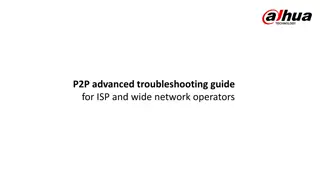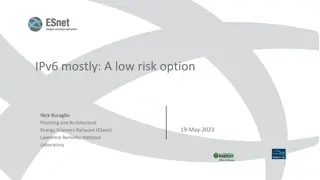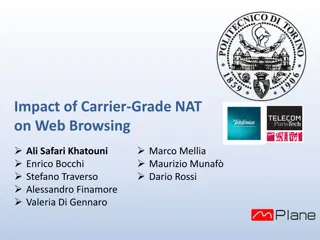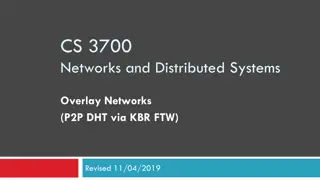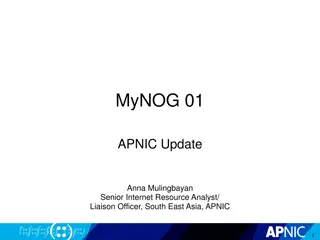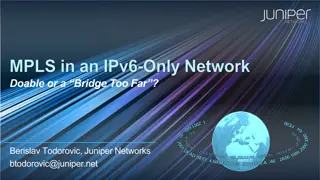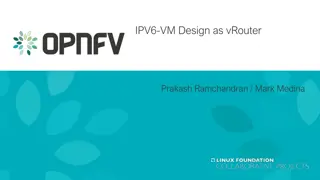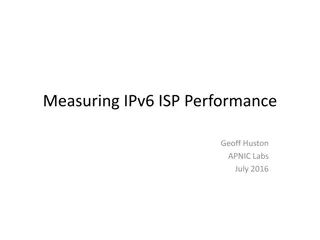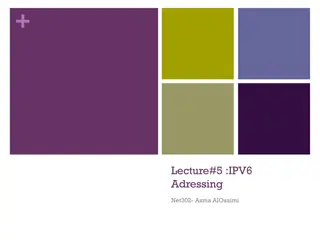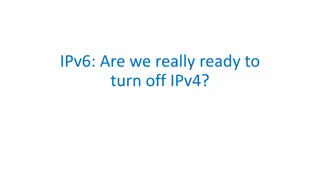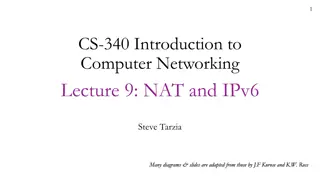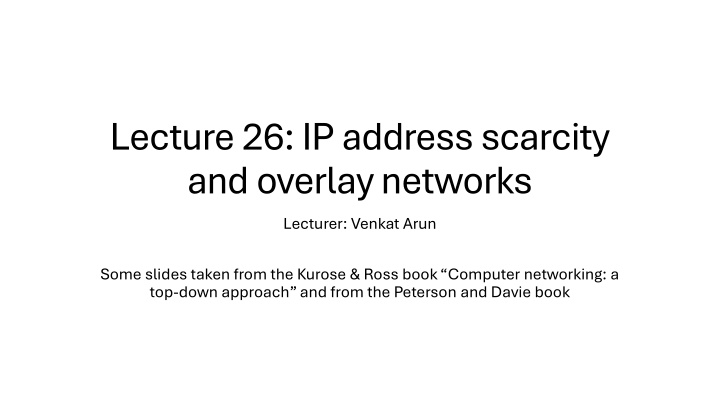
IP Address Scarcity and Network Address Translation
Explore the challenges posed by the scarcity of IPv4 addresses and how Network Address Translation (NAT) solutions help mitigate this issue. Learn about IPv6, NAT implementation, and the advantages it offers in managing IP address allocations effectively.
Download Presentation

Please find below an Image/Link to download the presentation.
The content on the website is provided AS IS for your information and personal use only. It may not be sold, licensed, or shared on other websites without obtaining consent from the author. If you encounter any issues during the download, it is possible that the publisher has removed the file from their server.
You are allowed to download the files provided on this website for personal or commercial use, subject to the condition that they are used lawfully. All files are the property of their respective owners.
The content on the website is provided AS IS for your information and personal use only. It may not be sold, licensed, or shared on other websites without obtaining consent from the author.
E N D
Presentation Transcript
Lecture 26: IP address scarcity and overlay networks Lecturer: Venkat Arun Some slides taken from the Kurose & Ross book Computer networking: a top-down approach and from the Peterson and Davie book
The IP Address Scarcity There are only 2^32 ~ 4 billion IP addresses, but there are more devices connected to the internet. How? Plus, like most resources on this planet, IP addresses are not distributed evenly Solutions IPv6 has 128-bit addresses Theoretically enough to address every grain of sand on earth. Since it is unlikely we will want to do that in the foreseeable future, we allocate addresses to prioritize convenience over efficiency Network Address Translation (NAT) Key Idea: Use port numbers (16 bit) in addition to the 32-bit IPv4 address
NAT: network address translation NAT: all devices in local network share just one IPv4 address as far as outside world is concerned local network (e.g., home network) 10.0.0/24 rest of Internet 10.0.0.1 138.76.29.7 10.0.0.4 10.0.0.2 10.0.0.3 datagrams with source or destination in this network have 10.0.0/24 address for source, destination (as usual) all datagrams leaving local network have same source NAT IP address: 138.76.29.7, but different source port numbers Network Layer: 4-3
NAT: network address translation all devices in local network have 32-bit addresses in a special private IP address space (10/8, 172.16/12, 192.168/16 prefixes) that can only be used in local network. These cannot be used in the public internet advantages: Just one IP address needed from provider ISP for all devices Security: we will discuss why NAT improves security 3 slides later Network Layer: 4-4
NAT: network address translation implementation: NAT router must (transparently): outgoing datagrams: replace (source IP address, port #) of every outgoing datagram to (NAT IP address, new port #) remote clients/servers will respond using (NAT IP address, new port #) as destination address remember (in NAT translation table) every (source IP address, port #) to (NAT IP address, new port #) translation pair incoming datagrams: replace (NAT IP address, new port #) in destination fields of every incoming datagram with corresponding (source IP address, port #) stored in NAT table Network Layer: 4-5
NAT: network address translation NAT translation table WAN side addr LAN side addr 138.76.29.7, 5001 10.0.0.1, 3345 1: host 10.0.0.1 sends datagram to 128.119.40.186, 80 2: NAT router changes datagram source address from 10.0.0.1, 3345 to 138.76.29.7, 5001, updates table S: 10.0.0.1, 3345 D: 128.119.40.186, 80 10.0.0.1 1 S: 138.76.29.7, 5001 D: 128.119.40.186, 80 2 10.0.0.4 10.0.0.2 138.76.29.7 S: 128.119.40.186, 80 D: 10.0.0.1, 3345 4 10.0.0.3 S: 128.119.40.186, 80 D: 138.76.29.7, 5001 3 3: reply arrives, destination address: 138.76.29.7, 5001 Network Layer: 4-6
NAT improves security! Devices outside the local network cannot initiate a connection to one inside the network. Why? The NAT table is only populated when a packet from inside goes outside. Until then, the NAT device does not know which to local IP/port it should forward an incoming packet Even organizations that have an abundance of IP addresses (e.g., US universities) use NATs to improve security
Instapoll: Can a server run behind a NET Suppose your ISP uses a NAT, Q1: how would you know? Q2: If you run a web server on your personal computer, can people outside open the website you are hosting? A1: If the IP address assigned by the DHCP is in one of the local prefixes (10/8, 172.16/12, 192.168/16 prefixes), it is a big clue that you are behind a NAT. This is the IP address you see when you run ifconfig as in assignment 1 A2: No, because clients initiate connections to a website s server. This is not possible if the server is behind a NAT. To understand why, look at how NAT works again
NAT: good or bad? NAT has been controversial: routers should only process up to layer 3 address shortage should be solved by IPv6 violates end-to-end argument (port # manipulation by network-layer device) NAT traversal: what if client wants to connect to server behind NAT? but NAT is here to stay: extensively used in home and institutional nets, 4G/5G cellular nets Network Layer: 4-9
IPv6: Let there be more addresses IPv6 uses an overlay network to enable a smooth transition from IPv4
IPv6: motivation initial motivation: 32-bit IPv4 address space would be completely allocated additional motivation: speed processing/forwarding: 40-byte fixed length header enable different network-layer treatment of flows Network Layer: 4-11
IPv6 datagram format flow label: identify datagrams in same "flow. (concept of flow not well defined). 32 bits priority: identify priority among datagrams in flow pri ver flow label hop limit payload len next hdr source address (128 bits) 128-bit IPv6 addresses destination address (128 bits) payload (data) What s missing (compared with IPv4): no checksum (to speed processing at routers) no fragmentation/reassembly (we did not cover this in class) no options (available as upper-layer, next-header protocol at router) Network Layer: 4-12
Transition from IPv4 to IPv6 not all routers can be upgraded simultaneously no flag days how will network operate with mixed IPv4 and IPv6 routers? tunneling: IPv6 datagram carried as payload in IPv4 datagram among IPv4 routers ( packet within a packet ) tunneling used extensively in other contexts (4G/5G) IPv6 header fields IPv4 header fields IPv4 payload IPv6 source dest addr IPv4 source, dest addr UDP/TCP payload IPv6 datagram IPv4 datagram Network Layer: 4-13
Tunneling and encapsulation Ethernet connects two IPv6 routers A B E F Ethernet connecting two IPv6 routers: IPv6 IPv6 IPv6 IPv6 IPv6 datagram Link-layer frame The usual: datagram as payload in link-layer frame IPv4 network connecting two IPv6 routers A B E F IPv6 IPv6/v4 IPv6/v4 IPv6 IPv4 network Network Layer: 4-14
Tunneling and encapsulation Ethernet connects two IPv6 routers A B E F Ethernet connecting two IPv6 routers: IPv6 IPv6 IPv6 IPv6 IPv6 datagram Link-layer frame The usual: datagram as payload in link-layer frame IPv4 tunnel connecting two IPv6 routers IPv4 tunnel connecting IPv6 routers A B E F IPv6 IPv6/v4 IPv6/v4 IPv6 IPv6 datagram IPv4 datagram tunneling: IPv6 datagram as payload in a IPv4 datagram Network Layer: 4-15
Tunneling IPv4 tunnel connecting IPv6 routers A B E F logical view: IPv6 IPv6/v4 IPv6/v4 IPv6 A B C D E F physical view: IPv6 IPv6/v4 IPv6/v4 IPv6 IPv4 IPv4 src:B dest: E src:B dest: E flow: X src: A dest: F src:B dest: E flow: X src: A dest: F Flow: X Src: A Dest: F Flow: X Src: A Dest: F Flow: X Src: A Dest: F Note source and destination addresses! data data data data data A-to-B: IPv6 E-to-F: IPv6 B-to-C: IPv6 inside IPv4 B-to-C: IPv6 inside IPv4 B-to-C: IPv6 inside IPv4 Network Layer: 4-16
How do two IPv6 routers discover each other? A large suite of protocols we will not cover in class, but the following methods are broadly used Manual Put the 32-bit IPv4 address in an IPv6 address so the IPv6 routers can discover each other while being transparent to the IPv4 routers (Somewhat) centralized databases that can be discovered by each IPv6 endpoint and keeps track of everyone else in the network.
IPv6: adoption Google1: ~ 40% of clients access services via IPv6 (2023) NIST: 1/3 of all US government domains are IPv6 capable Network Layer: 4-18
IPv6: adoption Google1: ~ 40% of clients access services via IPv6 (2023) NIST: 1/3 of all US government domains are IPv6 capable Long (long!) time for deployment, use 25 years and counting! think of application-level changes in last 25 years: WWW, social media, streaming media, gaming, telepresence, Why? 1https://www.google.com/intl/en/ipv6/statistics.html Network Layer: 4-19
Overlay Networks Overlay networks are a general way to deploy new protocols in a backwards compatible way P&D chapter 9
Overlay Networks Suppose the brown (lower) network already exists, but does not support your fancy new protocol X One option is to force everyone to support X. This is never going to happen in the real world The other option is to make participation optional. Nodes that participate form an overlay network (blue/top) on top of the physical network (gray/bottom) The blue nodes are not connected by physical links. Instead, they use the gray network to form virtual links
We have already seen several overlay networks IPv6 CDNs can be organized as an overlay network. Only some nodes participate. These cache whatever objects are most popular with the clients that they talk to The internet originally began as an overlay over the telephone network. To participate, you bought a dial-up modem that send data instead of human voice. This is why you head beep bops on the phone. A modem on the other end understood those messages. Sound produced by a dial-up modem


